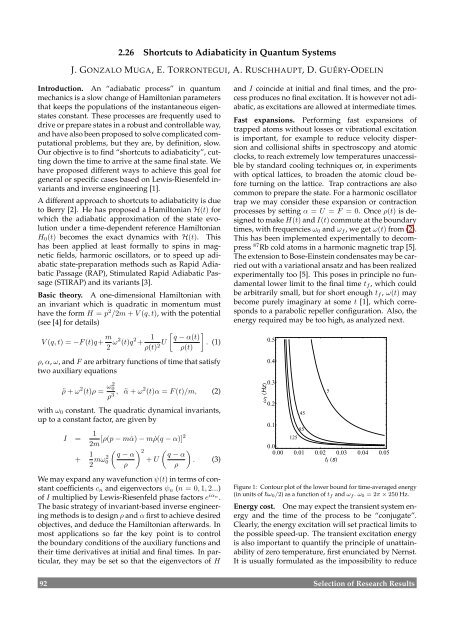Contents - Max-Planck-Institut für Physik komplexer Systeme
Contents - Max-Planck-Institut für Physik komplexer Systeme
Contents - Max-Planck-Institut für Physik komplexer Systeme
Create successful ePaper yourself
Turn your PDF publications into a flip-book with our unique Google optimized e-Paper software.
2.26 Shortcuts to Adiabaticity in Quantum Systems<br />
J. GONZALO MUGA, E. TORRONTEGUI, A. RUSCHHAUPT, D. GUÉRY-ODELIN<br />
Introduction. An “adiabatic process” in quantum<br />
mechanics is a slow change of Hamiltonian parameters<br />
that keeps the populations of the instantaneous eigenstates<br />
constant. These processes are frequently used to<br />
drive or prepare states in a robust and controllable way,<br />
and have also been proposed to solve complicated computational<br />
problems, but they are, by definition, slow.<br />
Our objective is to find “shortcuts to adiabaticity”, cutting<br />
down the time to arrive at the same final state. We<br />
have proposed different ways to achieve this goal for<br />
general or specific cases based on Lewis-Riesenfeld invariants<br />
and inverse engineering [1].<br />
A different approach to shortcuts to adiabaticity is due<br />
to Berry [2]. He has proposed a Hamiltonian H(t) for<br />
which the adiabatic approximation of the state evolution<br />
under a time-dependent reference Hamiltonian<br />
H0(t) becomes the exact dynamics with H(t). This<br />
has been applied at least formally to spins in magnetic<br />
fields, harmonic oscillators, or to speed up adiabatic<br />
state-preparation methods such as Rapid Adiabatic<br />
Passage (RAP), Stimulated Rapid Adiabatic Passage<br />
(STIRAP) and its variants [3].<br />
Basic theory. A one-dimensional Hamiltonian with<br />
an invariant which is quadratic in momentum must<br />
have the form H = p 2 /2m + V (q,t), with the potential<br />
(see [4] for details)<br />
V (q,t) = −F(t)q+ m<br />
2 ω2 (t)q 2 + 1<br />
U<br />
ρ(t) 2<br />
q − α(t)<br />
ρ(t)<br />
<br />
. (1)<br />
ρ, α, ω, and F are arbitrary functions of time that satisfy<br />
two auxiliary equations<br />
¨ρ + ω 2 (t)ρ = ω2 0<br />
ρ 3 , ¨α + ω2 (t)α = F(t)/m, (2)<br />
with ω0 constant. The quadratic dynamical invariants,<br />
up to a constant factor, are given by<br />
1<br />
I = [ρ(p − m ˙α) − m ˙ρ(q − α)]2<br />
2m<br />
+ 1<br />
2 mω2 2 <br />
q − α q − α<br />
0 + U . (3)<br />
ρ ρ<br />
We may expand any wavefunction ψ(t) in terms of constant<br />
coefficients cn and eigenvectors ψn (n = 0,1,2...)<br />
of I multiplied by Lewis-Riesenfeld phase factors e iαn .<br />
The basic strategy of invariant-based inverse engineering<br />
methods is to design ρ and α first to achieve desired<br />
objectives, and deduce the Hamiltonian afterwards. In<br />
most applications so far the key point is to control<br />
the boundary conditions of the auxiliary functions and<br />
their time derivatives at initial and final times. In particular,<br />
they may be set so that the eigenvectors of H<br />
and I coincide at initial and final times, and the process<br />
produces no final excitation. It is however not adiabatic,<br />
as excitations are allowed at intermediate times.<br />
Fast expansions. Performing fast expansions of<br />
trapped atoms without losses or vibrational excitation<br />
is important, for example to reduce velocity dispersion<br />
and collisional shifts in spectroscopy and atomic<br />
clocks, to reach extremely low temperatures unaccessible<br />
by standard cooling techniques or, in experiments<br />
with optical lattices, to broaden the atomic cloud before<br />
turning on the lattice. Trap contractions are also<br />
common to prepare the state. For a harmonic oscillator<br />
trap we may consider these expansion or contraction<br />
processes by setting α = U = F = 0. Once ρ(t) is designed<br />
to make H(t) and I(t) commute at the boundary<br />
times, with frequencies ω0 and ωf , we get ω(t) from (2).<br />
This has been implemented experimentally to decompress<br />
87 Rb cold atoms in a harmonic magnetic trap [5].<br />
The extension to Bose-Einstein condensates may be carried<br />
out with a variational ansatz and has been realized<br />
experimentally too [5]. This poses in principle no fundamental<br />
lower limit to the final time tf , which could<br />
be arbitrarily small, but for short enough tf , ω(t) may<br />
become purely imaginary at some t [1], which corresponds<br />
to a parabolic repeller configuration. Also, the<br />
energy required may be too high, as analyzed next.<br />
Ω fHz<br />
0.5<br />
0.4<br />
0.3<br />
0.2<br />
0.1<br />
125<br />
45<br />
85<br />
5<br />
0.0<br />
0.00 0.01 0.02 0.03 0.04 0.05<br />
tfs Figure 1: Contour plot of the lower bound for time-averaged energy<br />
(in units of ω0/2) as a function of tf and ωf . ω0 = 2π × 250 Hz.<br />
Energy cost. One may expect the transient system energy<br />
and the time of the process to be “conjugate”.<br />
Clearly, the energy excitation will set practical limits to<br />
the possible speed-up. The transient excitation energy<br />
is also important to quantify the principle of unattainability<br />
of zero temperature, first enunciated by Nernst.<br />
It is usually formulated as the impossibility to reduce<br />
92 Selection of Research Results
















